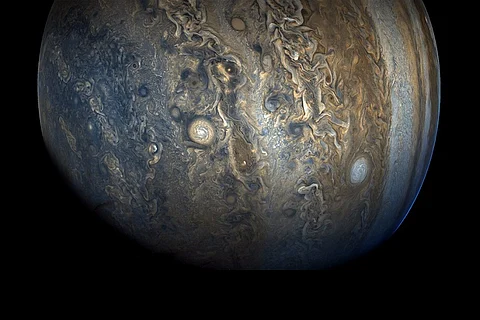

NASA released a stunning image of Jupiter's southern hemisphere on Friday, taken by the agency's Juno spacecraft.
The colour-enhanced view captures one of the white ovals in the "String of Pearls," one of eight massive rotating storms at 40 degrees south latitude on the gas giant planet, NASA said.
The image was taken on October 24, as Juno performed its ninth close flyby of Jupiter.
At the time the image was taken, the spacecraft was 33,115 kilometres from the tops of the clouds of the planet at a latitude of minus 52.96 degrees.
Launched on August 5, 2011, from Cape Canaveral, Florida, Juno arrived in orbit around Jupiter on July 4, 2016.
Due to solar conjunction on Jupiter, the confirmation was delayed by several days and data returned only on October 31.
Solar conjunction is the period when the path of communication between Earth and Jupiter comes into close proximity with the Sun.
During this period, no new instructions are sent or received from Juno, as it can corrupt the information due to interference from charged particles from the Sun.
Instead, a transmission moratorium is put in place, engineers send instructions prior to the start of solar conjunction and store data on board for transmission back to Earth following the event.
Juno's next close flyby of Jupiter will occur on December 16.
"There is no more exciting place to be than in orbit around Jupiter...our spacecraft is in great shape, and the team is looking forward to many more flybys of the solar system's largest planet," Ed Hirst, Juno project manager at NASA's Jet Propulsion Laboratory in California, had earlier said in a statement.
During its mission of exploration, Juno soars low over the planet's cloud tops, as close as about 2,100 miles (3,400 km).
During these flybys, Juno is probing beneath the obscuring cloud cover of Jupiter and studying its auroras to learn more about the planet's origins, structure, atmosphere and magnetosphere.
Stunning (adjective)
— NASA's Juno Mission (@NASAJuno) November 9, 2017
Definition - causing wonder or astonishment.
Synonyms - amazing, astonishing, astounding, awesome, eye-opening, fabulous, miraculous, prodigious, staggering, marvelous, stupendous, sublime, surprising, wonderful, wondrous.
#nailedit https://t.co/rNFPGra1Cu pic.twitter.com/dsZuNE8Rx9
New #JunoCam raw images from my latest #Jupiter flyby are available now. Download, process + share https://t.co/ijHwy72xXp #citizenscience pic.twitter.com/9hxZ3sf2GC
— NASA's Juno Mission (@NASAJuno) November 6, 2017
IANS inputs